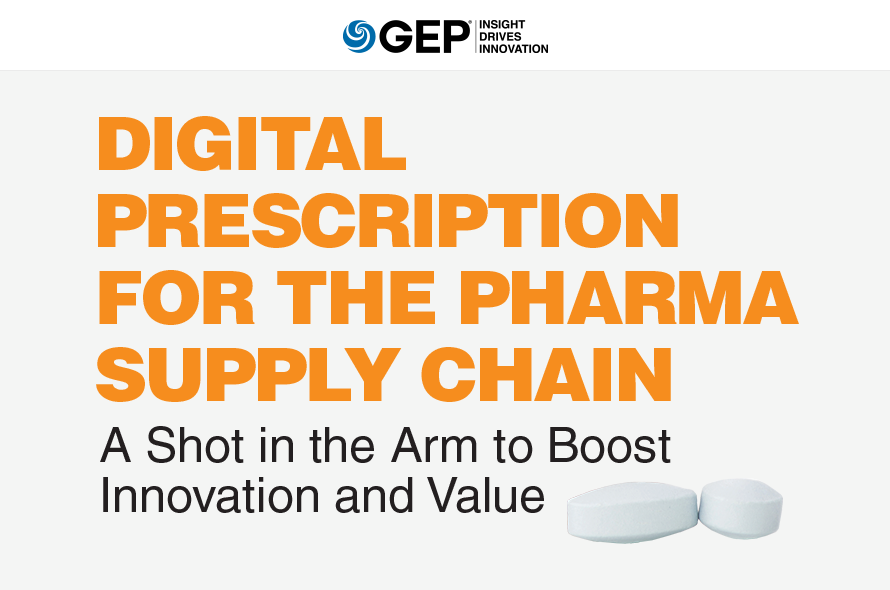In pharmaceutical enterprises, the supply chain is like the aorta, the main artery that branches out into every part of the body. And information is the lifeblood. How can pharma companies enable that information to flow freely, without constriction, so that it can drive innovation and ensure the health of the business?
A new white paper — Digital Prescription for the Pharma Supply Chain: A Shot in the Arm to Boost Innovation and Value — offers fresh insights into how fast-emerging digital supply chain technologies can not only boost the bottom line but also provide remedies for the toughest challenges of the pharma industry.
Why Read It:
- Why pharma companies need to prioritize the free flow of information and data
- Why digital SCM transformation will improve R&D agility and stakeholder engagement
- Practical steps supply chain managers can take now to ensure successful digital transformation
A compelling read for supply chain, procurement, and other pharma industry professionals.
OVERVIEW
Accelerating Innovation, Accelerating Outcomes
Digital transformation, by its very definition, cannot be done in half measures. It affects every aspect of the pharmaceutical enterprise — operations, research & development, clinical trials, manufacturing, marketing & sales, distribution, regulatory compliance — and, therefore, every link in the supply chain.
The lifeblood of any pharmaceutical company is information in its most current form. The ability to share data from every possible source across the enterprise — getting it out of siloes — is critical to driving innovation. It is the essential ingredient of digital transformation. Mobile communications, the Internet of Things (IoT), social media, artificial intelligence (AI), cloud computing, blockchain, and other fast-emerging technologies that generate or refine data are all playing significant roles in the digital transformation of the pharmaceutical industry. And through the strategic use of data analytics, pharmaceutical companies can make highly informed, groundbreaking decisions that accelerate innovation as well as profitability.

The goals: more transparency, deeper insights, wider collaborations — all with a view to driving innovation and delivering more meaningful, enduring, and better patient outcomes. This paper provides a glimpse of how digital technologies are transforming the entire pharmaceutical value chain.
WHY DIGITAL TRANSFORMATION? WHY NOW?
Creating Value for All Constituents and Stakeholders
To achieve true innovation in pharma takes a consistent, coordinated effort that is compounded by any number of intricate challenges to be overcome. Among them: creating a strategy for sustainable growth, having engines in place to increase revenue, keeping costs in check, and maintaining constant oversight to ensure strict compliance with all industry and government regulations.
Still, all these challenges orbit around the core challenge for pharmaceutical companies: anticipating and then meeting the demand for new treatments and medications.

An investment in R&D — where life-changing, life-saving discoveries happen — is an investment in the future, and future success. And a commitment to digital transformation is a way to accelerate that success.
The reason? Digital transformation is essentially about enabling all stakeholders to share and coalesce information more deeply, broadly and democratically across the enterprise. With access to information comes the ability to establish new predictive models with cause-and-effect analyses that help drive R&D innovation.
Digital Transformation in Pharma Is Real, but Not Widespread
There has been a recent upswing of pharma companies that are realizing or expect to realize positive returns from their data transformation initiatives. They understand that digital transformation is about value creation.
Some are using AI in bots/robotic process automation (RPA) or web-based platforms to streamline or automate processes. Others are employing machine learning (ML), cognitive computing, and advanced data analytics to create greater efficiencies, provide more flexibility, and enable faster speed to market.

Data throughout the enterprise is being leveraged more effectively, aggregated and accessed through dashboards to provide deeper analysis that more accurately tracks operations, customer insights, clinical findings and workflow with minimal manual intervention.
This more fluid flow of information is starting to promote greater organizational democratization — a flattened hierarchy fueled by more collaboration, less process, and the promise of future innovative achievement.
In effect, digital transformation is accelerating the transition from process-driven to strategically- driven enterprise. It’s a major shift that can empower employees to think more creatively, focusing their energy on business outcomes.
But for most of pharma, the journey toward digital transformation, and the innovation that follows, are just beginning. Pharma, in reality, is taking a cautious approach. To help promote understanding of the anticipated impacts of digital transformation within the pharmaceutical supply chain, we’ve identified five key areas in which the effort to drive innovation is highlighted.
FIVE KEY AREAS WHERE DIGITAL TRANSFORMATION OF SCM WILL DRIVE INNOVATION
1. R&D Agility
The hit ratio for medication releases is certainly consistent — but it is not high. Only one in 20 medications in clinical studies gets released1, and this has been the rate for the past 15 years. The reasons, of course, are entirely valid. Clinical trials are deeply complex. Masses of scientific data must be gathered from a multiplicity of sources to meet the needs of researchers, marketers, and regulators alike. It takes a lot of resources. A lot of time. And a lot of money.
But deeper data analysis has the potential to change that. It can enable researchers and product developers to leverage more data sources more effectively. With the ability to process greater amounts of clinical data, often in real-time, they can arrive at definitive conclusions more quickly, and therefore accelerate the R&D process. In effect, more data sources mean more insights to drive research further, faster.
One example is wearable technology. Patients are now wearing connected devices that gather real-time biometric data, providing a continuous feed to help R&D isolate specific medical need and perform predictive analysis. In fact, it can even be prescriptive analysis. With access to an individual patient’s DNA, and that of an entire patient group, it’s possible for researchers to be much more granular in the recommendations they bring forward because they can identify the kinds of patients who are most likely to benefit from a specific treatment. Johnson & Johnson/ Janssen is leading the use of wearable technology in trials, with GlaxoSmithKline, Takeda, Teva, and Pfizer not far behind2.

The ability to do deeper dives into data is helping to drive the fast-emerging field of pharmacogenomics — another example of how, with faster data processing and access, R&D can more quickly determine the relationships between specific genes and their response to certain kinds of drugs, particularly behavioral, cardiovascular and oncology medicines.
“One size fits all” doesn’t have to be the rule any more. Researchers can now perform smaller, more focused clinical trials with greater efficiency and agility, with less trial and error. And with more access to more data, combined with the ability to perform deeper analysis of specific sets of patient data, researchers are able to develop medications that can provide more personalized care.
2. Deeper Engagement Between Researchers, Physicians, Patients
The growing consumerization of technology is creating more opportunities for all constituents within the pharmaceutical value chain to connect — and to benefit.
Patients and caregivers can engage with one another through a number of channels, including apps, devices, or web-based forums. Likewise, researchers can gain access to clinical trials virtually through cloud-based and mobile technologies and perform real-time monitoring and analysis with speed and accuracy. With multiple means to share data in this always-on collaborative ecosystem, the ability to nurture deeper relationships that garner positive patient outcomes is becoming increasingly possible.

From the patient’s perspective, this will result in more individualized diagnosis, therapy and care, focused on his or her unique medical needs. And from the perspective of the pharmaceutical enterprise, it will mean establishing a more agile supply chain, factoring in new technologies and logistics that help support the well-being of the patient. New partnerships, too — the agile supply chain can more easily facilitate collaborations from disparate groups of different experts, and this will result in more third-party alliances and work agreements. With the right systems, the potential high costs and complexity of individualized care can be offset more readily.
Ultimately, a more agile supply chain means being more predictive and less reactive. Not only does this mean more personalized, patient-centric care, it means more anticipatory care, too. Drug production therefore can be adapted based on individual patient data, whether it comes from a physical sensor on a smart device — the Internet of Things (IoT) — or is mined from electronic medical records. Similarly, a patient’s treatment can be monitored remotely 24/7 using a sensor, an app, or even in the form of a digital pill, such as that developed by Proteus Digital Health3. Caregivers can determine whether the patient has taken the medication, track the medication’s effects, and adjust the dosage to better suit the patient’s needs.
3. Advanced Analytics
Advanced data analytics is at the core of the pharmaceutical supply chain’s digital transformation. Statistical modeling combined with ML is being used to measure and monitor all business processes within the enterprise, and these insights are helping to create significant efficiencies that are driving business performance. Pfizer, for example, has the “Precision Medicine Analytics Ecosystem” program, which provides insights into the interrelationships of genomic, clinical trial, and electronic medical record data, helping to expedite the delivery of new medicines for specific patient populations.

By using predictive analytics of causal data, the enterprise is able to improve forecast accuracy, helping to drive planning for procurement, sales, distribution and operations, among others. Every transaction within the supply chain can be tracked to help inform all decision-making. Data visualization, in the form of customizable dashboards, presents the information in an easy-to- understand, actionable format for faster determinations.
At the same time, ML, a form of AI, is helping to reduce the complexity of inventory management.Integrating with multiple suppliers globally, its algorithms can analyze data to predict the timing of inbound shipments. This helps to accurately determine delivery dates, balance inventory, and minimize or even eliminate delays in the manufacturing process.
Advanced data analytics is also helping to drive more insights into how products are performing in clinical trials. Through a number of independent information channels such as online communities, apps and wearable sensors, patients are sharing critical biometric data about their treatment experiences. The information being captured can then be used in registration filings to provide actual statistics on a treatment’s effectiveness. The data can also be used for physiological simulations such as 3D modeling to further advance the development of a product.
4. Real-Time Responsiveness
One of the most powerful promises of digital transformation is that it can enable real-time responsiveness throughout the supply chain. With always-on monitoring starting at the individual consumption level, it’s possible to accurately gauge demand, as well as optimize inventory management, order fulfillment, and delivery processes by geographic location.
With this information, it’s possible to determine service-level requirements across the supply chain while keeping costs in check throughout. With greater certainty of supply and demand, it’s also possible to pinpoint production batch sizes and their requisite lead times, even if they fluctuate significantly from week to week.

This supply chain agility, fueled by IoT devices, AI and ML, provides unprecedented oversight of the enterprise, deftly coordinating complex, time-sensitive business processes to help ensure timely decision-making and actions taken at every stage and every level. It marks the commencement of a new era for the pharmaceutical industry, and can reduce overall costs by as much as 20 percent if embraced holistically throughout the enterprise4.
5. Regulatory Compliance
Partnerships with third parties, strategic alliances, and mergers & acquisitions are all part of today’s pharmaceutical enterprise; and in this global, multifaceted, collaborative business environment, compliance with government and industry regulations plays an even more important role. The ability to retain control and ensure regulations are strictly followed is absolutely paramount.
For example, valuable patient data collected from electronic health records monitoring devices, used to design clinical trials and therapies, is also used by the FDA to help ensure safety, draft regulatory decisions, and determine clinical practice usage guidelines. Needless to say, it has to be accurate, and this is exactly where today’s data tools can be so powerful, with real-time tracking, feedback mechanisms, and research findings. These data tools are equally effective in meeting mass serialization standards and ePedigree verifications with accuracy and precision.
To help ensure regulatory compliance is maintained throughout the enterprise, staff training is also essential. By socializing this knowledge thoroughly, stricter adherence to regulations is far more likely. Customized web-based training tools with a comprehensive, easy-to-follow, well-designed UX can be readily deployed with continual updates to keep staff engaged and current.

DIGITAL TRANSFORMATION IS INEVITABLE. ARE YOU PREPARED?
There is no doubt that digital transformation is fast approaching the pharmaceutical enterprise — and supply chain managers are trying to decide what actions to take and when to take them. To prepare for this inevitable journey to a digital-first world, we’ve suggested a number of important steps you should take.
Next Steps
- Don’t think of digital as an add-on. It’s not just a business tool – it is the business because it touches every aspect.
- Create a “Special Ops” team. With representation from every department, its mandate is to ensure that everyone in the organization understands the potential of digital and embraces it.
- Walk first, but be prepared to run fast. The key to digital transformation is, after all, transformation. The ability to scale is the key to success.
- Start now. Help make sure that senior leadership truly understands the real potential of a digital transformation. The technology is here today. The time to get started is now.
Consider partnering with a third-party technology provider with deep experience within the pharma industry. By leveraging its understanding of the unique needs and challenges of pharma, it will be better able to provide a comprehensive, unbiased, informed assessment of your specific supply chain needs, and help you begin or further implement a full digital transformation.
References
- Andreessen Horowitz, “a16z Podcast: The Science and Business of Innovative Medicines,” a16z, 13 January 2019. Retrieved 23 May 2019 from a16z.com/2019/01/13/pharma-business-innovation-medicine-next-therapeutics/
- Laurie Withington, “Clinical Research on the Wearable Technology Bandwagon,” Informa Business Intelligence. Retrieved 23 May 2019 from pharmaintelligence.informa.com/resources/product-content/clinical-research-on-thewearable-technology-bandwagon
- Rebecca Robbins, “A ‘Digital Pill’ for Cancer Patients Is Rolled Out for the First Time, in Hopes of Improving Outcomes,” STAT, 17 January 2019. Retrieved 23 May 2019 from http://statnews.com/2019/01/17/a-digital-pill-forcancer-patients-is-rolled-out-for-the-first-time-in-hopes-of-improving-outcomes/
- Andreessen Horowitz, “a16z Podcast”

